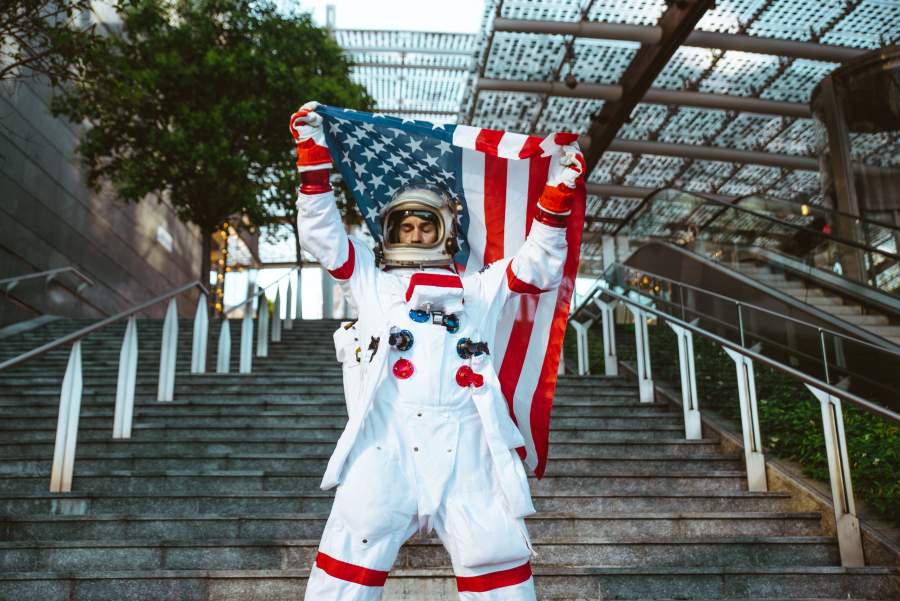7 Crore+ Customers

Affordable Premium

7 Crore+ Customers

Affordable Premium



When the Soviet Union put the first satellite in history into orbit on October 4, 1957, it instilled panic in non-communist nations worldwide. The Soviet Union was outpacing what was thought to be the Western Superpower, the United States, on the other side of the globe, leading to the introduction of a space program in the US.
The National Aeronautics and Space Act was designed and adopted by Congress in 1958. On July 29, 1958, The National Aeronautics and Space Administration (NASA) was established. Read ahead to know every detail about NASA and its missions.


The U.S. federal government's independent National Aeronautics and Space Administration (NASA) is in charge of the country's civil space programme and space and aeronautics research. It replaced the National Advisory Committee for Aeronautics (NACA) when it was founded in 1958 to give the American space development program a clear civilian focus and a focus on peaceful uses of space technology.
NASA conducts space missions, scientific research, and technological development to explore space, understand Earth, and enhance aviation. It has been instrumental in sending astronauts to the Moon, launching satellites that monitor our planet and the universe, and developing advanced technologies that benefit society.
NASA has served as the driving force behind the majority of US space exploration initiatives, like Project Mercury, Project Gemini, the Space Shuttle, the Skylab space station, and the Apollo Moon landing missions in 1968–1972. NASA currently manages the development of the Orion spacecraft and the Space Launch System for the lunar Artemis program and supports the International Space Station (ISS) and the Commercial Crew Programme.
Many people have some knowledge of NASA's operations. However, the majority are most likely unaware of the breadth of the agency's activities. Here are a few important things undertaken by NASA:
| Scientific Studies | Astronauts carry out scientific studies while in orbit. Thanks to satellites, scientists can discover more about Earth. Researchers in orbit examine the solar system and beyond. Innovations enhance flying in general and air travel in particular. |
| Moon and Mars Missions | NASA is starting a new initiative to send people to investigate the Moon and Mars. In addition to those significant missions, NASA carries out numerous other tasks. The organisation disseminates its knowledge to improve people's lives worldwide. Businesses can develop new spinoff goods based on NASA discoveries. |
| Provides Education | NASA assists educators in preparing the next generation of engineers, scientists, astronauts, and other NASA employees. These courageous ones will continue investigating the solar system and the cosmos. |
| Provides Funding for Space Initiatives | NASA has a long history of funding initiatives that thrill and educate communities, educators, families, and students about the wonders and excitement of space travel. |
| Provides Training | NASA provides training to assist educators in learning innovative approaches to teaching math, science, technology, and engineering. To encourage kids' enthusiasm for studying, the organisation regularly includes them in NASA missions. |
NASA's leadership in space exploration, aeronautics, and research is essential to the country's economic growth, national security, and cultural identity. NASA has four main strategic goals that are in line with its historic and ongoing purpose:
Here are 10 successful missions by NASA that have made significant contributions to space exploration and science:
Launched in 1972 and 1973, respectively, Pioneer 10 and Pioneer 11 were the first spacecraft to visit Jupiter and Saturn, the solar system's most spectacular gas giants. Pioneer 10 was the first spacecraft to pass through the belt of asteroids that surrounds Mars and Jupiter in the solar system.
Around nine months after launch, the spacecraft conducted its first flyby of Jupiter. It captured breathtaking close-ups of the planet's crimson regions and the Great Crimson Spot.
After passing Jupiter almost a year later, Pioneer 11 proceeded to Saturn, where it found two small moons orbiting the planet that had not been previously identified, in addition to a new ring. Both probes have ceased data transmission and continue their one-way trips outside the solar system.
The Voyager 1 and 2 probes soon followed the Pioneers' flybys. They discovered rings around Jupiter and the existence of volcanism on Jupiter's moon, among other significant findings regarding Saturn and Jupiter. Later, Voyager conducted the first flybys of Neptune, discovering that it weighs less than previously believed, and Uranus, where it detected ten new moons.
The two Voyager spacecraft are investigating the solar system's farthest region and the start of interstellar space. They have sufficient power to continue sending radio signals until at least 2025. At more than 100 times the distance from Earth to the sun and more than twice the distance from Pluto, Voyager 2 is now the furthest man-made object from Earth.
Though it may not be as well-known, the Wilkinson Microwave Anisotropy Probe (WMAP), launched in 2001, analyses the temperature of the radiation left over from the Big Bang with extraordinary accuracy. By charting variations in the cosmic microwave background radiation, the spacecraft has signalled a breakthrough in our understanding of the structure and age of the universe.
The WMAP measurements proved, among other things, that around 95% of the universe is made up of poorly understood substances known as dark matter and dark energy. They also provided a significantly more accurate estimate of the universe's age—13.7 billion years.
The Spitzer Space Telescope is another spacecraft that has significantly impacted cosmology and astrophysics. It used infrared light to survey the skies. The Earth's atmosphere blocks most of this light, which has a longer wavelength than visible light. Besides capturing stunning images of stars, galaxies, and nebulae, the telescope has yielded some significant scientific findings.
Spitzer was the first telescope to detect light from an extrasolar planet in 2005; most of these far-off worlds are only discovered through secondary gravitational impacts on their stars. In a separate finding, scientists speculate that the telescope may have even caught light from some of the universe's earliest stars.
These workhorse Mars rovers were only supposed to last 90 days, but they have exceeded expectations, Spirit ended its mission in 2011, and Opportunity ended its mission in 2019. The twin Mars Exploration Rovers, Spirit and Opportunity, touched down in January 2004 on different sides of the earth. Ever since, they have traversed the whole surface, peering into craters and meandering across uncharted terrain.
Evidence that liquid water once existed on Mars's surface is one of their most important discoveries. (A nod to Sojourner Rover, which introduced colour close-ups of Mars in 1997, coinciding with the launch of the Internet was growing enormously popular and, as a result, gaining a unique place in the hearts of millions of people who had never before had access to NASA mission images.
Launched in 1997, this joint NASA/ESA spacecraft arrived at Saturn in 2004. Ever since, the spacecraft has been circling the ringed planet, capturing breathtaking images of its rings, moons, and climate.
In 2005, the Huygens probe broke away from Cassini and travelled to Titan, the moon, where it plummeted through the atmosphere and touched down on solid ground. Saturn has been visited by earlier spacecraft, but Cassini is the first to orbit the planet and thoroughly study the system.
Using X-ray photons, the Chandra X-ray Observatory has been observing some of the most unusual and far-off celestial occurrences since 1999. Astronomers could not observe the universe in this high-energy, short-wavelength light until they launched Chandra into space because Earth's bothersome atmosphere cuts out the majority of X-rays.
Because of its extremely high-resolution mirrors, the observatory can view X-ray sources that are 100 times fainter than any other X-ray telescope. Among other firsts, when Chandra spotted the remnant Cassiopeia A, it gave scientists the first look at the smashed star that remains after a supernova.
The first instance of a man-made item soft landing on Mars occurred in 1976 during the Viking 1 probe's landing by NASA. The Soviet Mars 2 and 3 probes touched the surface, but they malfunctioned immediately.
At six years and 116 days, the Viking 1 lander is also the record holder for the longest-running Mars surface mission. Additionally, the spacecraft sent the first colour images from the Martian surface, giving us our first glimpse of that enigmatic red dot from above.
The Hubble Space Telescope is the most beloved of all NASA spacecraft, and it has a global reputation. The way regular people perceive themselves in the universe has altered due to its images. Additionally, the observatory has fundamentally altered science by producing too many scientific advances on astronomical problems to count.
NASA created a technology that might ultimately show stars, planets, nebulae, and galaxies in their fully detailed grandeur by launching an optical telescope to look up at the sky beyond Earth's tumultuous atmosphere.
In addition to being a landmark moment in human history, the Apollo missions were the first to return celestial objects to Earth. They significantly improved our understanding of the moon from a scientific standpoint. Many people (non-scientists, at least) weren't even convinced before Apollo that the moon wasn't made of cheese.
Through in-depth observations of the moon and the subsequent transportation of numerous moon rocks back to Earth, the Apollo astronauts collected data that allowed us to determine the moon's age, composition, and possible formation date.
These are only a handful of the amazing accomplishments that NASA has done throughout the years. They have genuinely altered the way we perceive and investigate the cosmos. Several of NASA's Most Notable Completions -
| Manned Mission to Moon | Apollo 11, the first manned space mission, saw American astronauts Neil Armstrong and "Buzz" become the first people to set foot on the moon on July 20, 1969. This accomplishment is regarded as one of the most significant in human history. |
| The Voyager Missions | NASA launched Voyager I and Voyager II in 1977. These spacecraft have returned numerous pieces of information concerning the outer solar system and beyond. |
| The Hubble Space Telescope | Since its 1990 launch, this instrument has given us breathtaking views of the cosmos. In 2004, NASA successfully landed the Mars rovers Spirit and Opportunity on the planet's surface. These rovers have carried out several scientific studies on the Martian Surface. |
| Development of Reusable Spacecraft Technology (Space Shuttle Programme) | The International Space Station was built using the Space Shuttle, which was used for several flights. Following the retirement of the final Space Shuttle, Atlantis, the programme ended in 2011. |
| Water found on Mars | Curiosity, NASA's Mars rover, found indications of liquid water on the Martian surface in 2015. This was a noteworthy finding since it raises the possibility that life exists on Mars. |
NASA continues to push the boundaries of human knowledge and exploration through its groundbreaking missions and research. As we look to the future, NASA's ongoing commitment to innovation promises to inspire generations and unravel the mysteries of our universe, fostering scientific advancements that benefit humanity as a whole.